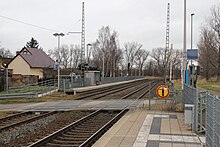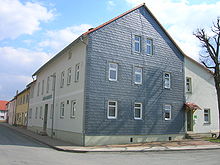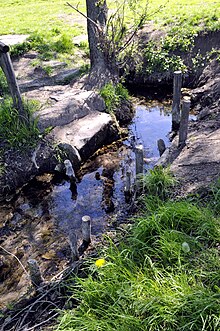Brawn bridges
|
Brawn bridges
Municipality of Wachsenburg
Coordinates: 50 ° 53 ′ 12 " N , 10 ° 53 ′ 38" E
|
|
|---|---|
| Height : | 254 m above sea level NHN |
| Residents : | 600 (2019) |
| Incorporation : | June 30, 1994 |
| Postal code : | 99334 |
| Primaries : | 036202, 03628 |
Sülzenbrücken is a district of the municipality of Amt Wachsenburg in the northern Ilm district in Thuringia . In the 8th century it played an outstanding role in the Christianization of Thuringia alongside Erfurt and Ohrdruf .
geography
Sülzenbrücken is located on the far northwestern edge of the Ilm district. The neighboring town of Apfelstädt, only two kilometers away , is already in the Gotha district . The area of the place belongs to the southern edge of the Thuringian Basin . The village itself is at an altitude of 254 m above sea level . The area is almost completely free of forests and is primarily used for agriculture. Sülzenbrücken is located on the Weidbach , a tributary of the Apfelstädt .
history
The area around Sülzenbrücken was probably settled at the beginning of the era. The salt spring located about one kilometer southwest of the village (a karst spring , the eponymous salt deposit has been completely depleted for at least two centuries) is said to have been a Celtic place of worship.
Around 741, Sülzenbrücken was chosen by Bonifatius as a mission station for the Christianization of the Thuringian regions. In the Brevarium Lulli , the village is described as Villa Sulzebruggun and consisting of 42 Hufen and 33 Mansen . It was the largest settlement of the Hersfeld estate in Thuringia after Gebesee . It is believed that Willibald von Eichstätt , an Anglo-Saxon relative of Boniface, had a church built there, ordained a priest in 739 and was appointed administrator of a district of seven churches. On October 21, 741 he received the episcopal ordination from Bonifatius and shortly afterwards went to Eichstätt to build a diocese there. The note of this incident in the Brevarium Lulli from the year 742 is considered to be the first written mention of Sülzenbrück.
Little is known about the history of the place from the following centuries. The village, located on a military road, was fortified and there were only three gates to enter: the Herrentor (demolished in 1842), the upper and the Mühltor. From 1640 Sülzenbrücken belonged to the lower county of Gleichen , whose sovereignty lay with the Duchy of Saxe-Gotha , later with the Duchy of Saxe-Coburg and Gotha . With the construction of the Diethendorf – Arnstadt railway line in 1866, the town received its own train station. The population remained relatively constant over the centuries, in 1900 the place had 447 inhabitants.
Since the formation of the state of Thuringia in 1920, Sülzenbrücken has been part of the newly formed district of Arnstadt . With the creation of the districts in the GDR , the community belonged to the Arnstadt district in the Erfurt district . In the course of the municipality reform in Thuringia, the village lost its status of an independent municipality in 1994 and became part of the Wachsenburg municipality in the Ilm district. With the dissolution of the municipality on December 31, 2012, the place came to the municipality of Wachsenburg . Due to the favorable traffic situation, the place is increasingly developing into a rural residential area.
economy
The village has been dominated by agriculture for centuries. Today there are only a few small businesses in town. The "Oldie-Scheune", a motor vehicle workshop that specializes in the restoration of classic cars , is well known in the region. There is also a vehicle and scrap disposal company as well as two restaurants and a children's pension. Most of the residents work in the surrounding economic centers of Erfurt and Arnstadt .
traffic
Sülzenbrücken is located on the K 24 district road from Holzhausen to Apfelstädt. Immediately to the north, the A4 motorway passes the village. The next junction is Neudietendorf .
Sülzenbrücken has a stop on the Neudietendorf – Arnstadt railway line , which is served every hour by regional trains of the Erfurt Railway and South Thuringia Railway . These travel to Neudietendorf and Erfurt in the north and to Arnstadt in the south, where the trains are separated. The front part of the train goes to Saalfeld , the rear part to Ilmenau .
societies
There are several registered associations active in the village. These include the local fire brigade club, the sports community Wachsenburg Haarhausen-Sülzenbrücken and a local and traditional club that organizes the annual fair.
Worth seeing
Village church
The center of the parish, which belongs to the parish of Holzhausen , is the St. Wiperti Church ( consecrated to St. Wigbert ) in Sülzenbrücken. This also includes Haarhausen , Bittstädt and Holzhausen. The church is considered to be one of the most splendidly decorated and painted churches in the region. Scenes from the Old and New Testament show the paintings in the image fields of the two surrounding galleries , one on top of the other . In front of the church there is a memorial for those who died in both world wars .
In the 12th century, the Romanesque church in the village was built as a fortified church with a high defensive tower and a double, strong wall ring, the inner wall of which was six to eight meters apart from the church. It was about three feet thick and four feet high. Hardly anything can be seen of the outer wall that enclosed the churchyard. In the outer ring, three gate buildings secured the entrances. In the south-eastern area of the wall there are still loopholes, clear characteristics of a fortified church. Below the wall wreath you can still see holes for inserting the wooden beams for the battlement. The outer ring was almost completely removed in the 19th century, for the most part in 1874/75. The inner part still exists and surrounds the village cemetery.
This fortification probably had a safety function for humans and animals as well as for the road leading past from Arnstadt in the direction of Apfelstädt and Tennstedt . In the centuries that followed, the rulers changed frequently. From 1561 to 1569 the later influential Lutheran theologian Martin Mirus was pastor in Sülzenbrücken. An old birthing chair, unique in Thuringia, was kept in the church until the end of the 20th century . This can now be seen on permanent loan in the Museum of Thuringian Folklore Erfurt .
In 1743 the church organ was rebuilt by the Wandersleben organ builder Johann Stephan Schmaltz and again in 1925 by the organ builder Rudolf Böhm from Gotha. Since the ceiling was lowered, the organ had to be partially removed and is no longer playable.
Apfelstädter Ried and Salt Spring
To the west of the village is the 18.5 hectare Apfelstädter Ried , a nature reserve. It has developed as so-called alternately moist grassland on a thick layer of peat and is the remainder of what was once a much larger flow-through bog (limestone bog). While the reed dries out almost completely in dry periods, it becomes a floodplain after heavier, longer-lasting rainfall or after the snow has melted, ideal conditions for special plants to thrive. The extensive sedge population is remarkable . The rich fauna is home to 131 species of birds, 41 species of snails and, in addition to 121 species of ground beetle , countless insects. The meadows owe their salinity to the salt spring (s). Thus, special species find favorable living conditions such as B. the common viper tongue , the salt rush or the single-skin rush. Regular mowing and removal of the clippings should reduce the nutrient content that has increased due to previous over-fertilization and intensive grazing and curb the spread of common reeds .
At the edge of Apple townspeople Ried as salt source of Sülzenbrücken is ⊙ called karst spring in a "Salty Wiesenaue". It can be reached via the well-signposted castle route of the Inselsberg - Drei Gleichen Geopark . The salt spring rises from a limestone crevice at a depth of about one meter. Because of its salt content, it was venerated as a sanctuary and fountain of youth for centuries . Their name was also the inspiration behind the naming of the place Sülzenbrücken: Sülzen was derived from the Old High German sulza (salt water). Since one can assume that the "Urthuringians" ( Hermundurs and Celts ) were settled in this area a few centuries before Sülzenbrücken was first mentioned in a document in 742 , the source has a minimum age of 1500 years. At least 200 years ago, the underground salt store was drained by the water, so that the spring was used as a cattle trough. After a cow got stuck in the mud and drowned, the spring was fenced in and made shallower by piling up earth. Today it is a popular destination, a seating area invites you to linger.
politics
At the time it belonged to the Wachsenburg community, Sülzenbrücken was the only part of the community that had its own mayor. Ludwig Frank held this position from 1999 to 2014. In the local elections in May 2014, Reymond Armster was elected as the new local mayor.
Personalities
- Willibald von Eichstätt (born October 22, around 700, presumably in Wessex in England; † July 7, 787 (or 781) in Eichstätt), Christian missionary, was bishop of Sülzenbrücken on October 21, 741 by Bonifatius in the presence of Witta von Büraburg consecrated, Wunibald (* 701 in Wessex; † December 18, 761 in Heidenheim) was consecrated as a bishop in Sülzenbrücken
- Martin Mirus (* 1532 in Weida; † August 14, 1593 at Schloss Karditz near Oschatz), German Lutheran theologian and Saxon court preacher, was pastor of Sülzenbrücken from 1561 to 1569
Individual evidence
- ↑ See also: Hauthaler: Willibald . In: Allgemeine Deutsche Biographie (ADB). Volume 43, Duncker & Humblot, Leipzig 1898, pp. 272-275.
- ↑ Dirk Koch: Village churches around the three equals . TGI Trachtengruppe Ingersleben, 2006, pp. 12–18
- ^ Martin Weber: Well-fortified churches in Thuringia . Frommannsche Buchhandlung, Jena 1935. p. 96
- ↑ Michael Köhler : Thuringian castles and fortified prehistoric and early historical living spaces. Jenzig Verlag, 2001, ISBN 3-910141-43-9 , p. 242.
- ↑ DUDEN, dictionary of origin
- ↑ Information board at the source
Web links
- Sülzenbrücken on amt-wachsenburg.de
- Private website about the place
- On the role of Sülzenbrückens in the work of Boniface ( Memento from September 29, 2007 in the Internet Archive )



